
Visit our website at: http://www.harborfreight.com
Email our technical support at: [email protected]
Owner’s Manual & Safety Instructions
Save This Manual Keep this manual for the safety warnings and precautions, assembly,
operating, inspection, maintenance and cleaning procedures. Write the product’s serial number in the
back of the manual near the assembly diagram (or month and year of purchase if product has no number).
Keep this manual and the receipt in a safe and dry place for future reference. 20l
When unpacking, make sure that the product is intact
and undamaged. If any parts are missing or broken,
please call 1-888-866-5797 as soon as possible.
Copyright
©
2020 by Harbor Freight Tools
®
. All rights reserved.
No portion of this manual or any artwork contained herein may be reproduced in
any shape or form without the express written consent of Harbor Freight Tools.
Diagrams within this manual may not be drawn proportionally. Due to continuing
improvements, actual product may differ slightly from the product described herein.
To ols required for assembly and se rv ic e m ay n ot b e i nc lu de d .
Read this material before using this product.
Failure to do so can result in serious injury.
SAVE THIS MANUAL.

Page 2 For technical questions, please call 1-888-866-5797. Item 61411
Important Safety Information
1. Wear ANSI-approved safety goggles and
heavy-duty work gloves during use.
2. Keep bystanders out of the area during use.
3. Do not use when tired or when under
the influence of drugs or medication.
4. This product is not a toy. Do not allow
children to play with or near this item.
5. Use as intended only.
6. Keep work area clean and well lit.
7. Inspect before every use; do not
use if parts are loose or damaged.
Do not use cracked or chipped tap/die.
8. Keep the handles clean, dry, and free
from oil and grease at all times.
9. The flutes on these tools are sharp
and can cut you. Handle with care.
10. Do not use any high-speed means, such as a
lathe or drill press, to cut threads with these
Taps and Dies. High-speed use will void the
warranty and may overheat the tool, causing
loss of heat-treatment and premature failure.
11. Taps and Dies are heat-treated, and
not designed to be sharpened. After
considerable use and with corrosion buildup
these tools may lose their cutting edge.
12. Use clamps (not included) or other
practical ways to secure and support the
workpiece to a stable platform. Holding
the work by hand or against your body is
unstable and may lead to loss of control.
13. Do not apply excessive force on the cutters.
Allow the tool to do the work. Use cutting oil
when tapping or threading hard materials.
Before using either taps or dies, test the material to determine that
it is not hardened by attempting to mark it with a file:
• If the material marks with a file,
material should be cuttable.
• If the material will not mark with a file,
do not cut threads to avoid tool damage.
Tap Instructions
TAPS are used to cut (tapping) or clean (chase) internal threads into
a pre-drilled hole, such as in a nut or component part.
1. To cut an internal thread, first select
the tap of the desired size and have
lubricating or cutting oil ready for use.
2. The proper hole size is very important to
successfully cut good threads. An oversized
hole will result in shallow threads, and
poor holding power. An undersized hole
may cause the tap to wear prematurely
or break. The correct hole size is
marked on the shank of each tap.
3. Insert the square end of the Tap into the
Tap Wrench, turn the threaded side of the
Tap Wrench to secure the Tap firmly.
4. Precisely align the tap with the direction
of the hole. THIS IS ESSENTIAL.
The first cut will help determine the
accuracy of the entire finished thread.
5. Start turning the Tap clockwise, keeping the
Tap aligned with the hole. As the Tap turns,
it will bite into the metal and create threads.
6. After every 1/4 to 1/2 turn of progress,
depending on material hardness, rotate
the Tap counterclockwise an equal
amount to prevent chips from building
up in the hole and breaking the tap.
7. Lubricate amply with cutting oil while
tapping. Proper lubrication will result
in smoother threads, and increased
tool life. Continue tapping until the Tap
passes through the workpiece, or the
desired thread depth is reached.
8. Carefully thread the tap out backwards
and clean out any chips from the hole.

Page 3For technical questions, please call 1-888-866-5797.Item 61411
Die Instructions
DIES are used to cut (threading) or clean (chase) external threads,
such as on a screw or threaded rod.
NOTE: It will be easier to start the Die correctly
if the end of the work material is slightly
chamfered with a grinder or file (not included).
1. Select the proper Die size for the rod
to be threaded. The Die can be no
larger than the rod stock, and should be
.005″to.010″smaller.Oversizedrodstock
may damage the die, and will make turning
it difficult. Slightly undersized rod stock
makes turning the die easier, and will result
in good threads for most applications.
2. Secure the workpiece in a vise or other fixture
(not included). Ensure that the workpiece will
not move or turn while it is being threaded.
Note that the workpiece may be damaged
by the vise during the threading process.
When possible, thread the workpiece
before cutting it to the final length
to eliminate the damaged area.
3. Insert the Die into the Die Wrench.
Note: An adapter ring is provided
for the smaller die sizes.
4. Align the groove on the side of the
Die with the Screw on the Die Holder.
Tighten the screw using the included
Screwdriver. Use the Screw on side of the
Die Wrench to secure the Die firmly in place.
Screw
Die
5. Place the chamfered side of the Die onto
the workpiece, being careful to precisely
align the Die perpendicular to the rod.
6. Begin turning the Die clockwise. The cutting
edges will begin to bite into the material, and
the Die will begin to thread itself onto the rod.
7. As you progress, apply lubrication,
using a high-quality cutting oil.
As with the Tap, reverse the Die to clear
the shavings after every 1/4 to 1/2 turn of
progress, depending on material hardness.
Continue this forward and back process,
using proper lubrication, until you have
cut the desired length of threads.
8. Then turn the Die counterclockwise
completely off the rod.
Maintenance
1. Clean immediately after use and apply a light
layer of oil or grease to prevent corrosion.
Note: The carbon steel parts of this
set are susceptible to corrosion.
Even light corrosion may reduce effectiveness.
2. Store tools in the provided case in a
secure location, out of the reach of
children, to protect them from moisture.
Record Product Serial Number Here:
Note: If product has no serial number, record month and year of purchase instead.
Note: Reference UPC 792363614115.

Limited 90 Day Warranty
Harbor Freight Tools Co. makes every effort to assure that its products meet high quality
and durability standards, and warrants to the original purchaser that this product is free from
defects in materials and workmanship for the period of 90 days from the date of purchase.
This warranty does not apply to damage due directly or indirectly, to misuse, abuse, negligence
or accidents, repairs or alterations outside our facilities, criminal activity, improper installation,
normal wear and tear, or to lack of maintenance. We shall in no event be liable for death,
injuries to persons or property, or for incidental, contingent, special or consequential damages
arising from the use of our product. Some states do not allow the exclusion or limitation of
incidental or consequential damages, so the above limitation of exclusion may not apply to you.
THIS WARRANTY IS EXPRESSLY IN LIEU OF ALL OTHER WARRANTIES, EXPRESS OR
IMPLIED, INCLUDING THE WARRANTIES OF MERCHANTABILITY AND FITNESS.
To take advantage of this warranty, the product or part must be returned to us with transportation
charges prepaid. Proof of purchase date and an explanation of the complaint must accompany
the merchandise. If our inspection verifies the defect, we will either repair or replace
the product at our election or we may elect to refund the purchase price if we cannot readily
and quickly provide you with a replacement. We will return repaired products at our expense,
but if we determine there is no defect, or that the defect resulted from causes not within
the scope of our warranty, then you must bear the cost of returning the product.
This warranty gives you specific legal rights and you may also
have other rights which vary from state to state.
Specifications
Tap & Die Scale SAE
Material Titanium Nitride Coated Alloy Steel
Tap & Die Sizes
1/4″-20 1/4″-28 5/16″-18 5/16″-24
3/8″-16 3/8″-24 7/16″-14 7/16″-20
1/2″-13 1/2″-20 9/16″-12 9/16″-18
5/8″-11 5/8″-18 3/4″-10 3/4″-16
7/8″-9 7/8″-14 1″-8 1″-14
26541 Agoura Road • Calabasas, CA 91302 • 1-888-866-5797
-
 1
1
-
 2
2
-
 3
3
-
 4
4
Pittsburgh Item 61411-UPC 792363614115 Owner's manual
- Type
- Owner's manual
- This manual is also suitable for
Ask a question and I''ll find the answer in the document
Finding information in a document is now easier with AI
Related papers
-
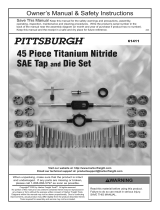 Pittsburgh Item 61411-UPC 193175321022 Owner's manual
Pittsburgh Item 61411-UPC 193175321022 Owner's manual
-
Pittsburgh 62831 Owner's manual
-
Pittsburgh 62832 Owner's manual
-
Pittsburgh 62831 Owner's manual
-
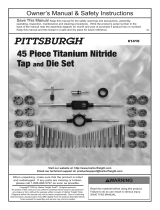 Pittsburgh 61410 Owner's manual
Pittsburgh 61410 Owner's manual
-
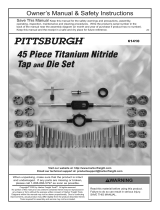 Pittsburgh 61410 Owner's manual
Pittsburgh 61410 Owner's manual
-
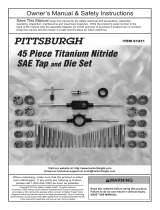 Pittsburgh 45 Pc Titanium Nitride Coated Alloy Steel SAE Tap & Die Set Owner's manual
Pittsburgh 45 Pc Titanium Nitride Coated Alloy Steel SAE Tap & Die Set Owner's manual
-
Pittsburgh 62831 Owner's manual
-
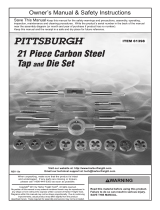 Pittsburgh 61398 Owner's manual
Pittsburgh 61398 Owner's manual
-
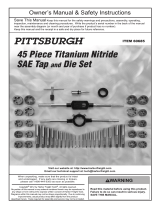 Pittsburgh 60685 Owner's manual
Pittsburgh 60685 Owner's manual
Other documents
-
Central Machinery 30 in. 3-In-1 Shear, Press Brake, and Slip Roll Owner's manual
-
Harbor Freight Tools Portable Electric Pipe Threader User manual
-
Central Machinery Item 62203 Owner's manual
-
Central Pneumatic Item 01110 Owner's manual
-
Central Pneumatic Item 96661-UPC 193175272614 Owner's manual
-
Harbor Freight Tools 30 in. 3-In-1 Shear, Press Brake, and Slip Roll Owner's manual
-
Central Machinery 17 in. 16 Speed Drill Press Owner's manual
-
Pittsburgh Automotive 56411 Owner's manual
-
Central Machinery Item 62353 Owner's manual
-
Chief Item 64869 Owner's manual









